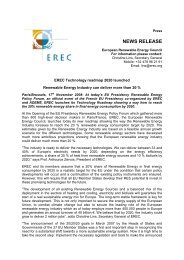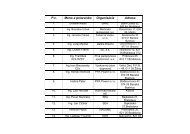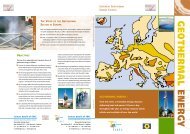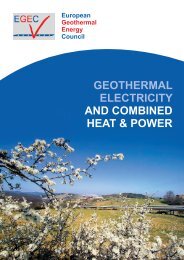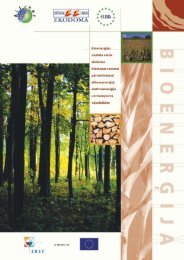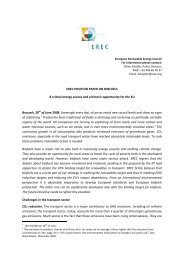A Pellet Road Map for Europe - Aebiom
A Pellet Road Map for Europe - Aebiom
A Pellet Road Map for Europe - Aebiom
- No tags were found...
Create successful ePaper yourself
Turn your PDF publications into a flip-book with our unique Google optimized e-Paper software.
ContentSummary . . . . . . . . . . . . . . . . . . . . . . . . . . . . . . . . . . . . . . . . . . . . . . . . . . . . . . . . . . . . . . . . . . . . . . . . . . . . . . . . . . . . . . . . . . . . . . . . . . . . . . . . . . . . . 5• Aim of this <strong>Road</strong> <strong>Map</strong>• <strong>Pellet</strong>s – a successful technology• The economics of using pellets• Energy security and social cohesion• Potential <strong>for</strong> pellets• Policy recommendations<strong>Pellet</strong>s – a new energy carrier <strong>for</strong> <strong>Europe</strong> . . . . . . . . . . . . . . . . . . . . . . . . . . . . . . . . . . . . . . . . . . . . . . . . . . . . . . . . . . . . . . . . . . . . 6The economics of pellets use . . . . . . . . . . . . . . . . . . . . . . . . . . . . . . . . . . . . . . . . . . . . . . . . . . . . . . . . . . . . . . . . . . . . . . . . . . . . . . . . . . . . 7<strong>Pellet</strong>s – a versatile fuel . . . . . . . . . . . . . . . . . . . . . . . . . . . . . . . . . . . . . . . . . . . . . . . . . . . . . . . . . . . . . . . . . . . . . . . . . . . . . . . . . . . . . . . . . 8Environmental advantages ....................................................................................... 9Status of pellet markets in <strong>Europe</strong> ............................................................................ 10Scenario <strong>for</strong> future development ...............................................................................11Conditions <strong>for</strong> sustained market growth of <strong>Europe</strong>an pellet markets . . . . . . . . . . . . . . . . . . . . . . . . . . . . . . . . 12• Awareness ............................................................................................................12• Incentives . ............................................................................................................13• Legislative support . . . . . . . . . . . . . . . . . . . . . . . . . . . . . . . . . . . . . . . . . . . . . . . . . . . . . . . . . . . . . . . . . . . . . . . . . . . . . . . . . . . . . . . . . . . . . . . . . .13• Quality of products and services . . . . . . . . . . . . . . . . . . . . . . . . . . . . . . . . . . . . . . . . . . . . . . . . . . . . . . . . . . . . . . . . . . . . . . . . . . . . . . . . . . .13• Monitoring programmes & competitions . . . . . . . . . . . . . . . . . . . . . . . . . . . . . . . . . . . . . . . . . . . . . . . . . . . . . . . . . . . . . . . . . . . . . . . . . 14• Reliable and stable supply and distribution systems . . . . . . . . . . . . . . . . . . . . . . . . . . . . . . . . . . . . . . . . . . . . . . . . . . . . . . . . . . . . . 14• Consumer confidence . . . . . . . . . . . . . . . . . . . . . . . . . . . . . . . . . . . . . . . . . . . . . . . . . . . . . . . . . . . . . . . . . . . . . . . . . . . . . . . . . . . . . . . . . . . . . . 14• Competition with the fossil fuel industry . . . . . . . . . . . . . . . . . . . . . . . . . . . . . . . . . . . . . . . . . . . . . . . . . . . . . . . . . . . . . . . . . . . . . . . . . 14Policy recommendations . . . . . . . . . . . . . . . . . . . . . . . . . . . . . . . . . . . . . . . . . . . . . . . . . . . . . . . . . . . . . . . . . . . . . . . . . . . . . . . . . . . . . . . . 15• Recommendations <strong>for</strong> policies at EU level . . . . . . . . . . . . . . . . . . . . . . . . . . . . . . . . . . . . . . . . . . . . . . . . . . . . . . . . . . . . . . . . . . . . . . . . 15• Recommendations <strong>for</strong> policies at national and regional levels . . . . . . . . . . . . . . . . . . . . . . . . . . . . . . . . . . . . . . . . . . . . . . . . . .17<strong>Pellet</strong>s, a clean homogeneous energy carrierwith very high energy content.Source: GEE EnergySummaryAIM of this <strong>Road</strong> <strong>Map</strong><strong>Pellet</strong>s — a modern <strong>for</strong>m of densified biomass offer hugeopportunities <strong>for</strong> the increased use of renewable energy in<strong>Europe</strong>. Today pellets are fully competitive with fossil fuels,particularly oil. <strong>Europe</strong>an companies have undisputedtechnology leadership both <strong>for</strong> domestic pellet heatingappliances, <strong>for</strong> commercial and industrial boilers and <strong>for</strong>large plants turning pellets into electricity and heat. <strong>Europe</strong>is also a global leader in pelletizing machinery, pellet logisticsknow how and in terms of production volume. Howevermarket development is still limited to a fairly small numberof member states. The purpose of this <strong>Road</strong> <strong>Map</strong> is tocreate awareness of the fascinating potential of this newway of biomass use. Its intention is also to show memberstates how to successfully develop national pellet markets.<strong>Pellet</strong>s – a successFUL technology<strong>Pellet</strong>s are a solid fuel produced from biomass, at presentmainly from wood residues. They are produced by a simpleand fairly cheap process of milling, drying and compactingwhich requires small amounts of energy.The key advantage of pellets compared to unprocessedbiomass are high density and high energy content, standardizedproperties and consequently reduced cost <strong>for</strong>transport storage and handling. The huge opportunity ofpellets lies in the fact that technologies <strong>for</strong> pellet productionand pellet use are fully developed and ready <strong>for</strong> themarket. Moreover they are highly competitive and have awide range of benefits compared to the use of fossil fuels.What is still missing is a general awareness of the potentialand the opportunities associated with pellet use.The economics of pellets USE<strong>Europe</strong> is using about 90 million tons oil equivalent of oil <strong>for</strong>heating purposes every year <strong>for</strong> households and services.By August 2008 wood pellets cost about 60 % less thanheating oil. While fuel costs are significantly lower, theinvestment costs <strong>for</strong> pellet heating systems are substantiallyhigher and represent a considerable barrier <strong>for</strong> marketuptake. There<strong>for</strong>e public financial incentives are important<strong>for</strong> the development of a successful pellet industry.Energy security and social Cohesion<strong>Pellet</strong>s used <strong>for</strong> residential or commercial heating replacepredominantly heating oil and natural gas and thuscontribute directly towards improving energy security in<strong>Europe</strong>.In member states with a high share of electric heatingpellet stoves provide a great possibility in replacing electricheating. Again the benefit in terms of energy security andcost reduction is significant.High fuel prices are creating a threat of energy poverty<strong>for</strong> millions of <strong>Europe</strong>an citizens. These people will not beable to properly heat their homes in winter due to the highprice of heating oil. <strong>Pellet</strong> stoves offer a solution <strong>for</strong> manyof these households, to cover their basic need <strong>for</strong> heat inan efficient, environmentally sound, and convenient way ataf<strong>for</strong>dable cost. At present 10-12 aweek are needed inorder to keep a living area com<strong>for</strong>tably warm with a pelletstove.Potential <strong>for</strong> pelletsAEBIOM estimates that by 2020 up to 80 million tons ofpellets could be used in the EU — this corresponds to 33million tons oil equivalent. As pellets can be produced fromvarious sources of biomass it is very difficult to estimate theoverall biomass potential in the EU <strong>for</strong> pellet production.However, in view of the great cost advantages of pellet use,particularly <strong>for</strong> heat production, it is likely that 15-20 % ofEU biomass resources will take the pellet route until 2020.Policy recommendations• Create stable and reliable incentives <strong>for</strong> investmentin pellet boilers and stoves.• Implement communication programs that createawareness <strong>for</strong> the benefits of using pellets bothin professional communities and among consumers.• Ensure a high quality level of products and services<strong>for</strong> using pellets as a heating fuel. An efficient/highquality technology can be introduced by linkingquality requirements to subsidies, via labellingschemes, competitions, training programs and monitoringprojects.• Apply regulatory policies that remove existingbarriers <strong>for</strong> pellet use and that create obligations <strong>for</strong>minimum levels of renewable energy use in buildings.• Pay attention to the opportunities <strong>for</strong> alleviatingenergy poverty by making pellet stoves available tolow income households.A <strong>Pellet</strong> <strong>Road</strong> <strong>Map</strong> <strong>for</strong> <strong>Europe</strong> 45 A <strong>Pellet</strong> <strong>Road</strong> <strong>Map</strong> <strong>for</strong> <strong>Europe</strong>
<strong>Pellet</strong>s – a new energycarrier <strong>for</strong> <strong>Europe</strong>The economics of pelletsWood pellets are a convenient and clean fuel producedfrom saw dust and wood shavings compressed underhigh pressure. In recent years in some places also logwood from thinning is used to produce pellets.<strong>Pellet</strong>s are cylindrical in shape and usually 6 – 10 mmin diameter. The average length is about 10 – 30 mm.Due to their high energy content and the convenientdelivery and storage feature, pellets are anideal fuel <strong>for</strong> replacing heating oil or gas. They are,beside biomass district heating, a key technology <strong>for</strong>increasing biomass utilisation in <strong>Europe</strong> and thusreplacing fossil fuel, natural gas or electricity in theheating sector.There are some additional reasons why pellets shouldbe supported in order to improve our energy systemand decrease environmental burdens of fossil fuels.• Significant reduction of CO 2compared to fossilfuels.• <strong>Pellet</strong>s can play a significant role in reducing thedependence of <strong>Europe</strong> on oil imports.• <strong>Pellet</strong> production can create jobs in rural areas.One of the most economic ways to use pellets isto burn them as fuel <strong>for</strong> domestic heating. Energycosts from pellets are currently 60 % lower than theenergy costs of fuel oil (<strong>for</strong> 2008).Fuel costs <strong>for</strong> residential heating (cent/kWh)<strong>Pellet</strong>s 3.55Natural Gas6.22Heating Oil 9.69LPG 10.85It should be mentioned at this point that a 30 %investment grant of 4000 <strong>for</strong> a domestic pelletboiler system would result in a subsidy of about6 per MWh of energy produced over the lifetime ofthe boiler. It also means a (public) cost of reducingthe CO 2emissions lower than 20 /t CO 2equivalent.In addition the heating fuel cost <strong>for</strong> the householdwould be reduced by about 1000 per year.Total heating cost with pellets is much lowercompared to oil, even if capital cost is higher*400035003687Operation costFuel costCapital costKey characteristics of pelletsElectricity 17.3230003042Heating value4,8 kWh/kg pelletsor 0,41 toe/t pelletsor 2 t pellets = 1000 l heating oil0 2 4 6 8 10 12 14 16Source: E-Control, IWO, Primagaz, pro<strong>Pellet</strong>s Austria; August 6 th , 20081825002000Water content below 10 %1500Ash content below 0,5 %Density 0,65 t/m 3The production of pellets from solid biomass is atechnology which trans<strong>for</strong>ms biomass to an energycarrier efficiently. Biomass is milled, dried, anddensified. The result is a homogenous solid fuelwith a much higher energy density. State of the arttechnology of pellet production can achieve overallconversion losses both <strong>for</strong> drying, milling and densificationthat are lower than 10 %. Excess heat fromthe production is recycled and used <strong>for</strong> drying theraw material <strong>for</strong> new pellets.<strong>Pellet</strong>s, a clean homogeneous energy carrierwith very high energy content.Source: GEE EnergyA full cost analysis shows the still existing barrier <strong>for</strong>the introduction of wood pellet heating. Investmentcosts <strong>for</strong> a state of the art pellet boiler systemincluding all side costs amount to 14,000 – 17,000.These high capital costs result in an economic situationthat does not represent a strong incentive toreplace existing oil heating systems that are stillworking well. The high investment does not onlylimit the economic benefit but is also a seriousconstrains <strong>for</strong> the liquidity of households. For thisreason investment subsidies are vital to achieve afast market introduction. A similar situation existswith respect to pellet stoves. While pellet stovesare much smaller in investment compared to pelletboiler systems they could be acquired by familieswith lower incomes, those that would not buy suchstoves without investment support.10005000Oil* case of a single family house 15 kW boiler<strong>Pellet</strong>sThus directing public money to support a changeof the heating system from oil to pellets is cheaperthan buying CO 2certificates with many additionaladvantages such as:• Improved security of supply.• Less expenses <strong>for</strong> households.• Incentives <strong>for</strong> the regional economyincluding job creation.A <strong>Pellet</strong> <strong>Road</strong> <strong>Map</strong> <strong>for</strong> <strong>Europe</strong> 67 A <strong>Pellet</strong> <strong>Road</strong> <strong>Map</strong> <strong>for</strong> <strong>Europe</strong>
<strong>Pellet</strong>s – a versatile fuelEnvironmentaladvantages<strong>Pellet</strong>s have been used in domestic heating applicationssince they were invented after the first oilcrisis. Later they were also used in district heatingnetworks. Recently the use of pellets <strong>for</strong> electricityproduction has also increased significantly.Today we can distinguish between 3 types of users:• Small scale residential pellets users with ademand of less than 10 tons pellets per year. Theyuse pellets <strong>for</strong> the heating of individual houseson the basis of pellet stoves, like <strong>for</strong> example inItaly, or in pellets boilers <strong>for</strong> warm water heatingsystems. The delivery is organised using bags(<strong>for</strong> pellet stoves) or automatic blow in systems,where trucks blow the quantity needed <strong>for</strong> oneyear in a pellet storage room or container.• Medium scale users with a demand between 10and 1000 tons per year. Typical users in this sizeare companies, hotels, the service sector, biggerresidential units. This market share is growingrapidly due to the escalating prices of heatingoil.• Large scale users with a demand above 1000tons/year. Power plants, industries, big districtheating companies; they might use severalhundred thousands tons of pellets per year in asingle plant.<strong>Pellet</strong>s can be used in many different ways:The main usage should be <strong>for</strong> energy purposes;like in domestic heating boilers ...... or district heating plants, as well as Combined Heat andPower plants, due to the high efficiency and environmentalfriendliness of pellets ...… but also other ways to use pellets are imaginable.Source: VAPO Source: GEE Energy Source: VAPO<strong>Pellet</strong>s are an excellent fuel <strong>for</strong> residential andcommercial heating. <strong>Europe</strong> is using about 90 Mtoeof oil and more than 170 Mtoe of natural gas <strong>for</strong>heating purposes every year <strong>for</strong> households andservices (Eurostat). Heating with pellets is muchcheaper than heating with fuel oil. The rapid conversionof existing fuel oil heating systems by pelletheating systems can play a significant role inreducing the dependence of <strong>Europe</strong> on oil and gasimports.<strong>Pellet</strong> stoves <strong>for</strong> residential heating are also wellsuited to replace electric heating. Given the vastamounts of electricity used in <strong>Europe</strong> <strong>for</strong> heatingthere is a particular advantage of introducing pelletuse to reduce electricity demand in winter. <strong>Pellet</strong>stoves also offer fairly low investment costs (approx.2000) while producing quite significant amountsof renewable heat.<strong>Pellet</strong>s are also used <strong>for</strong> the production of green electricity.The advantage of pellets is that they are veryeasy to use in existing coal fired power plants. Theutilisation of pellets in power plants could supportbalancing supply and demand fluctuations in theheat sector, making pellets a future large worldwideenergy commodity.gr CO2/kWh heat<strong>Pellet</strong>s offer opportunities <strong>for</strong> very large CO 2savings both within the heat and electricity sectors.Source: Jungmeier, 2008450400350300250200150100500403OilOil VS <strong>Pellet</strong>s <strong>for</strong> heat-91%37<strong>Pellet</strong>sA particular advantage of pellet utilisation is thelow environmental impact which is obvious both inthe production process, during transport (zero environmentaldamage in case of spillage) and also inuse.Modern pellet combustion equipment producesextremely low amounts of air pollution. <strong>Pellet</strong>scontain much lower amounts of sulphur than oil orcoal. They do contain certain amounts of nitrogenwhich leads to slightly higher NOx emissions. It mustbe kept in mind however, that the NOx is recycledin the same way as carbon: plants take up nitrogenfrom the soil as a nutrient; it is stored in the biomassand released during combustion to be returned tothe soil by the rain again.Due to perfect combustion control the small amountof dust that is emitted is composed of inorganicsalts, most of which are water soluble and pose asignificantly lower risk to health than other types offine dust.<strong>Pellet</strong>s are also a very effective way to reduce CO 2emissions. The combustion in modern pellet boilerscan reach more than 90 % of efficiency which allowsthe replacement of a high amount of heating oiland natural gas. High greenhouse gas savings alsoapply when using pellets in dedicated CHP plantswhere they replace coal. The CO 2emitted during thecombustion of biomass originates from CO 2taken upby the <strong>for</strong>est (closed carbon cycle) which means thatit doesn’t increase the overall CO 2emissions in theatmosphere.gr CO2/kWh electricity1200100080060040020001027CoalCoal VS <strong>Pellet</strong>s <strong>for</strong> electricity-93%73<strong>Pellet</strong>sA <strong>Pellet</strong> <strong>Road</strong> <strong>Map</strong> <strong>for</strong> <strong>Europe</strong> 89 A <strong>Pellet</strong> <strong>Road</strong> <strong>Map</strong> <strong>for</strong> <strong>Europe</strong>
Conditions <strong>for</strong> sustainedmarket growth of<strong>Europe</strong>an pellet marketsLEGISLATIVE SUPPORTAn interesting new approach regarding supportingregulations has been realised in the U.K., in Spainand in Germany. This approach is based on legalrequirements <strong>for</strong> buildings to meet a certain shareof their energy demand with renewable energies. Itremains to be seen how successful such regulationsare and if they are also able to enhance the use ofrenewable energy in existing buildings.AwarenessThe recent exorbitant increase of fossil fuel costs hasled to a situation, in which the use of pellets is highlycompetitive. Due to the fact that this developmentis very recent, only few people have yet realised,how advantageous a switch to pellets would be. Theresult is an oversupply of pellets and still hesitantmarket development in many countries in 2008.The lack of awareness regarding the role of energysupply <strong>for</strong> heat production is present at all levels:• The political levelThe EU has in the past only issued legislationregarding biofuels and the electricity market.• The level of potential customersA small young industry does not have the capacityto address and in<strong>for</strong>m potential customers aboutthe advantages of their product in a similar wayas large utilities or oil companies can.• The level of related professionalsThe lack of awareness also applies to the relevantprofessional communities such as architects,planners, installers, construction industries, etc.These communities involve millions of persons EUwide that need to be addressed and in<strong>for</strong>med.A solution <strong>for</strong> the above mentioned problems wouldbe publicly funded comprehensive communicationprogrammes, highly viable demonstration projects,studies that highlight the economic impacts and themarket potential, etc.A first communication programme would need tobe launched at the <strong>Europe</strong>an level addressing policymakers of member states. They need to be in<strong>for</strong>medabout the significant potentials of this sector andabout supportive policies that have proven to besuccessful in the countries with advanced marketdevelopment.It would be necessary to investigate at the nationallevel, which market segments are most promising inthe particular national context in terms of climaticsituation and the existing structures of heat supply.Based on these investigations focussed approachescan be applied to address the most promising marketsegments and the related professional communitiesthat offer services to these segments.If significant market penetration is to be achieved,professional public relations and advertisingcampaigns are needed to speed up the diffusion ofin<strong>for</strong>mation on the benefits of pellet heating amongthe respective target groups.Source: LatgranIncentivesHigh investment costs <strong>for</strong> pellet heating systems arethe most important barrier <strong>for</strong> market introduction.All countries that have seen a dynamic market developmenthave either stimulated market developmentby high taxes on fossil fuels or by financial incentives<strong>for</strong> pellet heating systems (or both). Successfulincentives must fulfil a number of criteria:• Predictability:Sudden changes, such as discontinued subsidieshave a profoundly disturbing effect on markets.From this point of view tax credit can be veryeffective, as all potential customers benefit inthe same way and the administrative hurdle isminimised.• Quality criteria:Successful financial support schemes have linkedthe availability of the support to quality criteria,both <strong>for</strong> the installed appliances and also <strong>for</strong> theservices of installation.• Monitoring programs:Monitoring programs are necessary to evaluatethe quality of the established installations andsupport learning processes, particularly <strong>for</strong> theinvolved professional communities.• Communication programs:If communication programs are linked to subsidyprograms the effect on market developmentcan be enhanced significantly. Very often thecommunication aspect is neglected and onlyfew typical innovators are benefiting from thesubsidy schemes.Source: GEE EnergyIn Germany a binding requirement to replaceheating systems that are above a certain age or thatcannot comply with certain efficiency or emissionregulations has been introduced to mobilizethe market. Of course regulatory support can alsoinvolve the removal of barriers in terms of buildingregulations etc.Quality of productsand servicesThe careful management of the quality of productsand services is a fundamental precondition <strong>for</strong>the sustained success of a new energy technology.Particularly in a situation where markets are growingfast due to political incentives, there is a significantdanger, that poor products and services cause heavydamage to the reputation and image of a new technology.Many examples in the past show that theseproblems can lead to a sudden collapse of markets,and very slow recovery processes. “Profit hunters”trying to make quick money can cause these problems.As a consequence it is inevitable that policiesare in place that ensure only high quality productsenter the market.Labelling of pellet appliancesKey elements of a successful quality managementare the establishment of certification and labellingschemes <strong>for</strong> pellet boilers and stoves. Labellingschemes are important to allow potential customersto distinguish good from bad products.The importance ofpellet standardizationToday there are several national pellet standardsin use among pellet producers throughout <strong>Europe</strong>.<strong>Pellet</strong>s produced according to a standard need tocomply with certain quality criteria such as ash,sulphur and moisture content of the fuel Differentmarket segments require different quality levels.A <strong>Pellet</strong> <strong>Road</strong> <strong>Map</strong> <strong>for</strong> <strong>Europe</strong> 1213 A <strong>Pellet</strong> <strong>Road</strong> <strong>Map</strong> <strong>for</strong> <strong>Europe</strong>
<strong>Pellet</strong>s truck delivering pellets to a private household.The highest quality is needed <strong>for</strong> small scale pelletsstoves, the lowest <strong>for</strong> pellets used <strong>for</strong> co-firing in bigcoal power plants.The new <strong>Europe</strong>an standardization work on solidbiofuels has a great potential to streamline terminology,quality and other aspects that are vital <strong>for</strong> afunctioning <strong>Europe</strong>an pellet market. A new <strong>Europe</strong>anstandard <strong>for</strong> pellets (CEN 335) is under way whichwill fulfil the needs of the market.Monitoring programmes& competitionsExtensive monitoring programmes should be establishedin an early phase of market deployment thatevaluate realized projects, check customer satisfaction,measure the annual efficiency of heatingsystems in the field and identify potential qualityproblems. Monitoring projects should be organisedin a way that lead to direct feed back to the involvedindustry and service sectors. Competition has oftenbeen a successful way of creating attention <strong>for</strong>quality issues.Reliable and stable supplyand distribution systemsThe establishment of effective supply and distributionsystems requires significant upfront investments.It is important to give clear signals to supply sideindustries that give them the confidence that theseinvestments are worthwhile and supportive publicpolicies will not be discontinued shortly.International trade will be an important elementSource: VAPOto secure a reliable and substantial supply of rawmaterials. Large biomass resources exist in countrieswith availability of land and beneficial climate conditions.The establishment of constructive models ofcooperation with such countries will be an importantelement of securing long term supply with pellets.Recent experiences have shown that short termchanges of demand due to climate variations orsudden rapid market growth can cause significantchallenges <strong>for</strong> supply structures and lead to suddenprice increases with detrimental implications <strong>for</strong>further market growth. Storage facilities could playan important role <strong>for</strong> stabilizing and enhancing thesecurity of supply.Consumer confidenceAt present in <strong>Europe</strong> several hundred thousandprivate house owners are using pellets — in the futurethis might be millions of houses. Large consumerssuch as district heating or power plants normallyhave the flexibility to switch between pellets andfossil fuels, while small scale users don’t have thispossibility. To gain the confidence of small scale usersthey have to get a priority in the delivery of pelletsin case of a pellet shortage and they expect ratherpredictable prices as compared to fossil fuels. In anycase, the supply security of small pellet users at areasonable and competitive price is a very importantissue in developing the market.Competition withthe fossil fuel industryExperiences in countries, where pellets have alreadyreached significant market shares show, thatfossil fuel industries can launch rather destructivecampaigns to damage the image of the new competitor.Given the vast financial resources of existingenergy industry, the potential impacts are obvious. Away out of this problem could be to create incentives<strong>for</strong> these industries to enter the market themselves— e.g. by establishing possibilities to receive carboncredits also <strong>for</strong> small scale systems. Political agreementswith the energy industry could be another wayof preventing aggressive negative campaigning.Policy recommendationsRecommendations <strong>for</strong>policies at EU levelRES directiveThe RES directive currently under discussion in theCouncil is a key step <strong>for</strong>ward <strong>for</strong> renewable heat in<strong>Europe</strong>. For the first time renewable heat is consideredwithin the <strong>Europe</strong>an targets as well as in thenational targets. National renewable actions planshave to be developed and it is certain that memberstates will realise the importance to address thehuge heat market covering roughly 50 % of the finalenergy consumption. Introducing minimum sharesof renewable in new houses and certification of heatinstallers are other key features in this directive.The directive is still under discussion (October 2008)and the following amendments would improve themarket conditions <strong>for</strong> pellets:• Interim targets should be mandatory to ensurefull commitment of the member states from thebeginning.• Guidelines <strong>for</strong> national actions plans should beas precise as possible to ensure that the heatmarket is not neglected.• When planning heat installations in industrialand residential areas (article 12 paragraph 3),the use of renewable energy <strong>for</strong> heat should bemandatory.Quality of nationaLaction plansIn order to enhance the quality of national actionplans with respect to developing the heat sector andthe use of pellets as fuel in particular the Commissioncould initiate a road show addressing national policymakers and supply them with examples of good andsuccessful policies.A very important instrument is also the briefing ofpolicy makers about the direct impacts of policymeasures and the costs/benefits of different policymeasures. It is of great interest to offer this kind ofin<strong>for</strong>mation in an understandable way.Labelling schemes<strong>for</strong> heating devicesThe labelling of household devices has been a greatsuccess in terms of trans<strong>for</strong>ming markets towardsmore efficient appliances. It should be implementedin a similar way <strong>for</strong> biomass heating devices. It isfundamental, that the labelling scheme is specific<strong>for</strong> the different types of heating devices such aspellet stoves, pellet boilers, etc. Both efficiency andemission levels of appliances should be consideredin labelling schemes.©Istockphoto.comA <strong>Pellet</strong> <strong>Road</strong> <strong>Map</strong> <strong>for</strong> <strong>Europe</strong> 1415 A <strong>Pellet</strong> <strong>Road</strong> <strong>Map</strong> <strong>for</strong> <strong>Europe</strong>
Energy Balance*Certification, including energy and CO 2balances, is implemented in Belgium18%16%14%12%10%8%6%4%2%0%Sea/river transportLocal transport<strong>Pellet</strong>isingGermanyThe Netherlands* Energy balance calculated as equivalent electricity and fossil fuels used <strong>for</strong> productionand transport compared with net electricity produced from pellets. Source: Ryckmans, 2008Source: VAPOEU certified professionaleducation schemesSimilar to the <strong>Europe</strong>an Computing Drivers LicenseECDL that has become a widely accepted standardit should be considered to establish a “EU biomassheating drivers licence” <strong>for</strong> installers, that makessure that all key issues <strong>for</strong> the efficient installationand operation of biomass heating systems areknown.Cooperation programswith countries with highbiomass potentialIn the medium term <strong>Europe</strong>an biomass resourcesmay need to be complemented with biomassresources from countries with high production potentialin terms of climate and available land. In view ofalready visible trends towards resource nationalismaccess to such sources can only be secured by longterm policies of cooperation that establish mutualbenefits.Important will be the assurance that importedbiomass is produced in a sustainable way. There<strong>for</strong>ethere is a need of certification schemes which areeasy to use, effective and af<strong>for</strong>dable in order to guaranteean environmentally sound production chainof pellets, whatever its origin (imported or locallyproduced).Baltic Sweden Russia CanadaExperiences have been gained in the last years bypower producers on certification of pellets. It includestraceability of the pellets along the production andtransport chain. Several sustainability criteria havebeen taken into account like <strong>for</strong>est management,local environmental impacts of the pellets productionplants, and even energy and CO 2balances (<strong>for</strong>which the Belgian system is particularly advanced).Source: GEE EnergyRecommendations <strong>for</strong>policies at nationaland regional levelsVisible demonstration projectsFor countries that have seen no or very little marketdevelopment the starting point <strong>for</strong> market developmentcan be well communicated demonstrationprojects. Public buildings have particular advantagesin terms of communication and creating trustand credibility <strong>for</strong> the technology.Procurement policiesfavouring pellet heatingCreating a market is the most important task at thebeginning. Enterprises must have projects to startwith. Procurement policies can be very supportivein this respect.Assessment of suitablemarket niches <strong>for</strong> pellet useBe<strong>for</strong>e targeted national policies can start it must beclear, where particularly attractive opportunities <strong>for</strong>pellet use exist. Due to the profound differences inclimatic conditions and heating habits these marketniches can vary from member state to member state.Once they are identified policies can focus theirsupport measures on these promising segments.Financial incentivesFinancial incentives are indispensable <strong>for</strong> marketstart up. Financial incentives should reduce the highupfront investment costs significantly, they shouldbe predictable (predictably declining is fine), theyshould be linked to quality criteria and include bothmonitoring and communication programmes.Link existing subsidyschemes to RES useIn some member states subsidy schemes mayexist, that just need slight modifications in orderto promote the use of pellets. Schemes supportingthe construction of social housing e.g. could requirerenewable heating systems as precondition <strong>for</strong> thesubsidy.A <strong>Pellet</strong> <strong>Road</strong> <strong>Map</strong> <strong>for</strong> <strong>Europe</strong> 1617 A <strong>Pellet</strong> <strong>Road</strong> <strong>Map</strong> <strong>for</strong> <strong>Europe</strong>
Source: VAPOAEBIOM organised a workshop on pellets inJune 2008 to discuss the content of this <strong>Pellet</strong> <strong>Road</strong>map.Quality criteria <strong>for</strong>products and servicesHigh quality products and services are a fundamentalprecondition <strong>for</strong> sustained market growth. The mosteffective way of en<strong>for</strong>cing adequate quality levels is,to link quality requirements with financial incentives.This has been demonstrated in many successfulcases of supporting policies.Supply securityand training programsA dialogue with the pellet industry should beconducted on how security of supply can be guaranteedall the way from producer to end user. Adequatetraining of professional installers also needs to beimplemented and has been implemented in mostcountries with successful market development.Monitoring programs<strong>for</strong> new installationsClose monitoring of realised projects in the useof pellets is of fundamental importance to identifyquality issues and stimulate learning processesamong the involved professionals right from thestart. The later monitoring takes place, the greater isthe damage to the market caused by poor per<strong>for</strong>mingprojects.Communication campaignsOnce the appliance market and pellet supply isreasonably well established, communicationprograms are needed to create a general interest inthe new technology. Such communication programsshould be publicly financed as the involved companiesare often too small to fund them. Also publiccommunication is more credible that companyadvertisements.Regulatory policiesRegulations requiring a minimum amount of renewableheat <strong>for</strong> new buildings are mentioned in thedraft <strong>Europe</strong>an directive on renewable and areconsidered as an effective way to promote the trans<strong>for</strong>mationof the heat market. Particular attentionneeds to be given also to the issue of existing heatingsystems that are outdated and should be replaced.Regulations that speed up the phasing out of oldheating systems could be one approach to address thisissue.Programs addressinglow income householdsEnergy poverty is rapidly becoming an issue withrising fuel prices. Support <strong>for</strong> low income householdsto buy pellet stoves is an excellent solutionwhich achieves both environmental goals and socialgoals at a very reasonable price. Special programs<strong>for</strong> converting social housing blocks to pellet heatingare another opportunity.Commit fossil fuelindustry to fair playNational policy makers should consider addressingestablished energy businesses and committing themto fair play concerning renewable energies. Examplesof “successful” dirty campaigning exist, that hadvery negative impacts on market development.AcknowledgementAEBIOM would like to thank Christian Rakos, pro<strong>Pellet</strong>s Austria,<strong>for</strong> his special contribution to the content of this <strong>Road</strong>map.How to contact AEBIOMPRESIDENTKopetz HeinzFranz Josef Kai 13A- 1010 ViennaTel. +43 1 533 07 97 0Fax +43 1 533 07 97 90Email. kopetz@biomasseverband.atwww.aebiom.orgSECRETARY GENERALJean-Marc JossartCroix du Sud 2 bte 11B- 1348 Louvain-la-NeuveTel. +32 10 47 34 55Fax +32 10 47 34 55Email. jossart@aebiom.orgEUROPEAN AFFAIRS MANAGEREdita VagonyteRenewable Energy HouseRue d'Arlon 63-65B- 1040 BrusselsTel. +32 24 00 10 22Fax +32 25 46 19 34Email. vagonyte@aebiom.orgA <strong>Pellet</strong> <strong>Road</strong> <strong>Map</strong> <strong>for</strong> <strong>Europe</strong>18
EUROPEAN BIOMASS ASSOCIATIONGold Sponsorswww.thecleanenergycompagny.comwww.vapo.fiwww.gee-energy.comSilver Sponsorswww.expobioenergia.comwww.bionovus.ltwww.latgran.comgraphic design: www.mardi.be




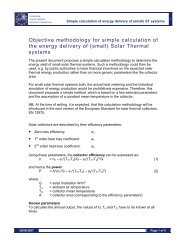
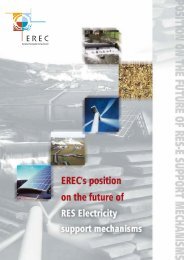

![Energy [R]evolution - Greenpeace](https://img.yumpu.com/47174859/1/184x260/energy-revolution-greenpeace.jpg?quality=85)
